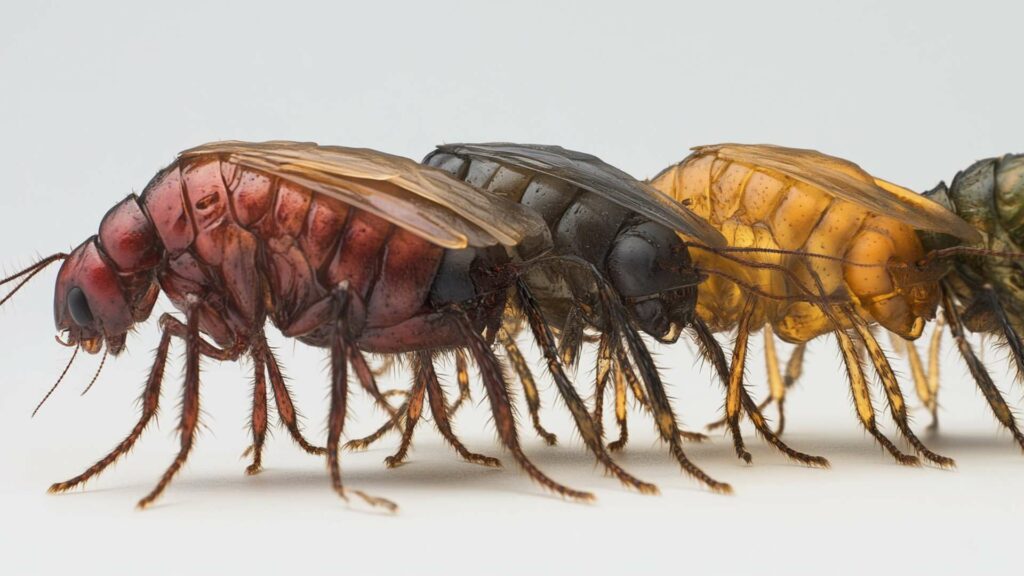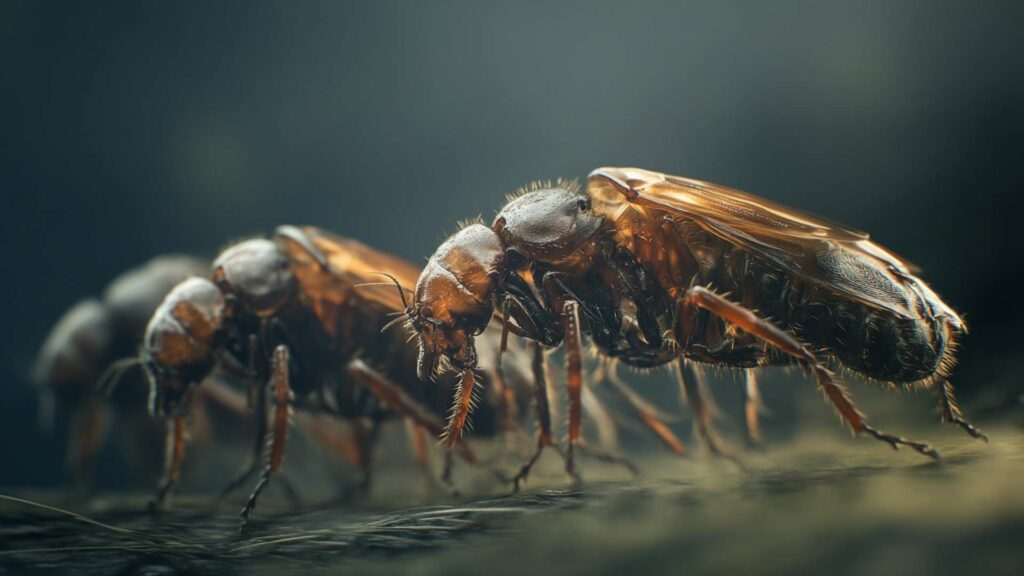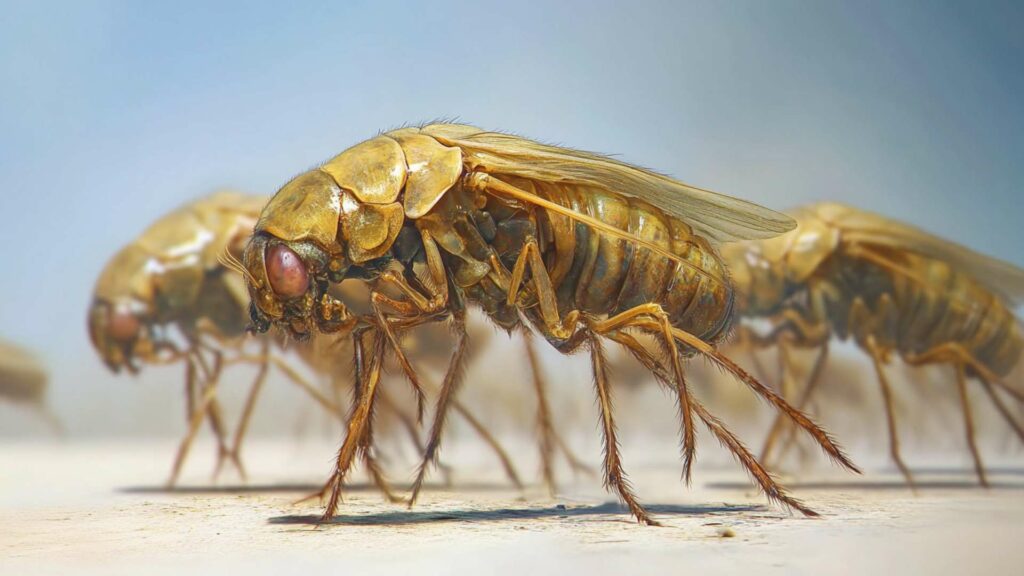Fleas – those tiny, annoying pests that can wreak havoc on our furry friends, bite humans, and make us itch like mad. They may be small, but don’t underestimate their impact on humans and animals alike. These bloodsucking parasites can cause severe discomfort, transmit diseases, and even lead to secondary infections.
It’s no wonder we are constantly on the lookout for ways to control them. But let’s take a step back and ask ourselves a curious question: Do fleas have a preference for specific environments?
Can they be picky about where they decide to set up camp? Well, my fellow flea-fighting aficionados, hold onto your scratching fingers because today we’ll embark on an exploration of female flea name preferences!
Brief Explanation of Fleas
Before we delve into the world of flea preferences, let’s quickly understand what these pesky critters are all about. Fleas are wingless insects that belong to the order Siphonaptera. They feed exclusively on blood—yes, you heard it right—and most commonly infest mammals like dogs, cats, and even us humans!
The entire life cycle of fleas comprises four stages: eggs, larvae, pupae, and adults. Female fleas lay their eggs in the host animal’s fur or bedding.
These eggs develop into larvae within a few days and eventually spin cocoons where they transform into pupae. Adult fleas emerge from these pupae fully equipped to start biting.
The Impact of Fleas on Humans and Animals

Now that we know what fleas are all about let’s talk about their impact on our lives—the not-so-pleasant part. When an animal is flea-infested (and oh boy can they multiply fast), these tiny vampires feast upon their blood causing relentless itching and discomfort.
Their bites often turn into red welts or blisters, and in some cases, they can cause allergic reactions. Beyond causing distress, fleas are notorious for transmitting diseases.
Some of the most well-known examples include the bubonic plague and typhus. Additionally, frequent scratching due to flea bites can lead to secondary infections that require medical attention.
It’s not just our furry friends who suffer the flea problem; humans are also at risk. If your pet has a flea infestation, chances are you’ll find yourself being bitten too.
Those tiny nuisances jump off your pet’s fur and onto you for their next blood meal. So it’s crucial to tackle these critters head-on and prevent future infestations.
Do Fleas Have a Preference for Specific Environments?
And now we arrive at the heart of our inquiry: Do fleas prefer certain environments over others? The answer is a resounding yes!
Fleas may not have personal preferences like we do when it comes to choosing favorite vacation spots, but they certainly have environmental inclinations that influence where they thrive. Factors such as temperature, humidity levels, host availability, and environmental conditions all play a role in shaping a flea’s life cycle and preferences.
By understanding these factors and how they affect flea populations, we can take proactive measures to control them effectively. Stay tuned as we navigate through the nitty-gritty details of flea preferences in different environments!
We’ll explore everything from urban areas teeming with potential hosts to rural settings where farm animals play host to these bloodsucking parasites. But hey, why stop there?
We’ll also uncover lesser-known preferences like indoor environments or altitude variations that impact flea populations. So put on your detective hats and let’s embark on this journey together—to conquer those pesky fleas once and for all!
Understanding Fleas
Overview of flea characteristics and life cycle
When it comes to dealing with pesky fleas, it’s essential to understand the very critters that cause so much nuisance. Fleas are tiny wingless insects that belong to the Siphonaptera order. These nimble creatures have flattened bodies, allowing them to effortlessly navigate through fur or feathers.
Typically, most fleas encountered by pet owners are cat fleas (Ctenocephalides felis). To truly grasp the impact of fleas on our lives, we must delve into their life cycle.
Fleas undergo a complete metamorphosis, which means they go through four distinct stages: egg, larva, pupa, and adult. Female fleas lay their eggs on their hosts – a passing animal or even in outdoor areas where pets may roam freely.
Once laid, these tiny eggs develop into larvae within one to twelve days. Flea larvae are elusive creatures that tend to hide in dark and humid environments such as carpets or bedding.
They feed on organic matter like flea droppings, flea feces, and skin debris until they spin cocoons and enter the pupal stage. In this stage, they transform into fully formed adult fleas.
Importance of understanding flea preferences for effective control
Now that we have a better understanding of flea characteristics and their life cycle, we can appreciate the importance of comprehending their preferences when it comes to our controlling flea infestations effectively. Different stages of flea development occur in various locations around our homes or outdoor spaces where pets frequent.
For instance, adult fleas usually reside on your beloved furry friend while laying eggs continuously throughout their entire life span – which can last several weeks if conditions are optimal. By understanding these preferences and focusing on key areas like pet bedding or furniture where your pet rests/sleeps indoors, you can effectively disrupt the adult flea’s life cycle.
Regularly washing your pet’s bedding in hot water and vacuuming these areas can help eliminate eggs, larvae, and even adult fleas. Fleas also favor shady outdoor areas with organic matter like leaf litter or moist soil.
By keeping these environments tidy and clear, you can discourage flea populations from establishing themselves nearby. Understanding their preferences allows us to focus our control efforts on where they are most effective, thus preventing future infestations.
In addition to direct control measures, understanding flea preferences enables pet owners to take preventive actions. For example, if you are aware that fleas tend to congregate in certain outdoor areas during specific seasons, you can take measures to protect your pet accordingly.
Regular use of both flea treatments and preventives on your pets can significantly reduce the risk of heavy infestations. Remember, prevention is always better than dealing with an existing infestation.
By gaining insight into the life cycle and preferences of fleas, we equip ourselves with the knowledge necessary to combat these tiny pests effectively. Stay diligent in keeping your environment clean and your pets protected from cat fleas – together we can ensure a flea-free existence!
Factors Influencing Flea Preferences
Temperature and Humidity
When it comes to the survival and reproduction of fleas, temperature and humidity play a crucial role. Fleas have a preferred range of temperatures that enable their survival.
Typically, fleas prefer temperatures between 70°F-85°F (21°C-29°C), with higher temperatures being more favorable for their development. This is why flea infestations tend to peak during the warm summer months when temperatures are at their highest.
Humidity levels also impact flea development. High humidity provides an ideal environment for flea eggs, larvae, and pupae to thrive.
In fact, fleas require a humidity level around 70% or higher for optimum development. Moisture helps in maintaining an appropriate environment for the survival of developing fleas by preventing dehydration and supporting their growth.
Host Availability

Fleas exhibit a preference for certain hosts based on various factors. Different species of fleas have different host preferences—some favor dogs and cats, others prefer cats, or even wildlife like rodents or deer.
The host’s body heat plays a significant role in attracting fleas, as they are drawn to warmth like moths to a flame. Additionally, certain hosts emit odors that are enticing to fleas, making them more likely targets.
The availability of hosts also influences flea preferences since it determines where the majority of flea populations will reside and thrive. For instance, if you live in an area densely populated with dogs or cats, there is a higher chance of encountering flea infestations because these animals act as ideal hosts.
Environmental Conditions

Fleas show distinct preferences when it comes to environmental conditions where they can proliferate successfully. They tend to favor shaded areas with organic matter such as leaf litter or dense vegetation because these environments provide protection from direct sunlight and extreme weather conditions.
Shaded areas offer the ideal conditions for flea eggs, larvae, and pupae to survive and develop. On the other hand, fleas avoid direct sunlight and extreme weather as it can be detrimental to their survival.
Sunlight exposure can dehydrate flea populations, leading to decreased viability. Similarly, extreme cold or heat can also negatively impact a flea population’s development and survival.
By understanding these factors that influence flea preferences, we can take appropriate measures to prevent future infestations. From maintaining optimal temperature and humidity levels in our homes to reducing organic debris in shaded areas of our yards, we can make our living spaces less favorable for fleas.
Additionally, regularly grooming our pets with a flea comb and using oral medications or topical treatments recommended by veterinarians can help keep them free from fleas. Considering natural solutions to flea traps like diatomaceous earth or seeking professional pest control services when facing severe flea problems ensures we tackle these pests effectively.
Specific Environments Preferred by Fleas
Urban Areas
Fleas have a particular affinity for urban areas due to the high population density, which provides them with numerous potential hosts. In cities, where humans and pets live in close proximity, flea infestations can quickly become a problem.
Fleas live and thrive in urban parks, gardens, and areas with abundant wildlife such as squirrels and birds. These outdoor spaces offer ideal conditions for fleas to breed and multiply.
The warm and moist environment found in parks provides the perfect habitat for flea eggs to develop into worm-like larvae. Moreover, these areas often have shaded spots like trees or bushes that offer protection from direct sunlight.
To make matters worse, fleas don’t just confine themselves to outdoor areas but can also find their way into homes in urban settings. When a flea-infested pet enters a house, it can unleash a full-blown infestation if not promptly addressed.
Flea eggs can fall off pets onto carpets and furniture where they hatch into larvae that feed on organic debris like shed skin or pet dander. These larvae then spin cocoons to enter the pupal stage before emerging as adult fleas weeks or even months later.
Rural Settings
Rural settings are not immune to flea problems either. Farm animals provide an attractive host for fleas due to their warm-blooded nature.
Cows, horses, sheep, and other livestock can harbor fleas on their bodies or in their living environments without showing signs of discomfort from bites. As such, rural areas with farms tend to have higher flea populations compared to regions without large-scale animal husbandry.
Additionally, wildlife plays a significant role in contributing to flea infestations in rural settings. Rodents like mice and rats are common carriers of fleas; they scurry through fields and barns spreading these pests wherever they go.
Deer, which are prevalent in many rural areas, can also harbor fleas and bring them closer to human habitation. These animals act as mobile carriers, introducing fleas to new areas and increasing the risk of infestations.
In both urban and rural environments, it is essential to implement effective flea control measures. Regularly using flea collars and treating pets with flea control products recommended by veterinarians helps prevent infestations from taking hold.
Additionally, frequent vacuuming of carpets and pet’s bedding, combined with proper disposal of the vacuum bag or cleaning canister far from living areas or outdoor trash containers, reduces the likelihood of flea eggs surviving the outdoor trash container and reinfesting your home. If an infestation does occur despite preventative efforts, professional pest control services may be necessary to effectively eliminate the problem by using targeted insecticides or treatments like synthetic pyrethrins that specifically target fleas while minimizing risks to humans or pets.
Remember that a proactive approach is crucial in managing flea populations since these tiny insects can rapidly multiply and cause discomfort through itchy bites. By understanding the preferences of fleas within specific environments – whether urban or rural – it becomes easier to adopt strategies that will reduce their presence and keep both humans and pets safe from these pesky parasites.
Lesser-Known Preferences
Indoor Environments: Making Themselves at Home
When we think of fleas, our minds often wander to the outdoor areas where these pesky critters lurk. However, it’s essential not to overlook their affinity for indoor environments, especially when our beloved pets are involved.
Fleas have a particular fondness for carpets, bedding, and furniture where our furry companions rest and sleep. These cozy spots provide the perfect habitats for these unwelcome guests.
Carpets become prime real estate for fleas due to carpet fibers and their warm and comfortable nature. The fibers offer protection and insulation while also trapping flea eggs and larvae that may have fallen off your pet.
Similarly, bedding and furniture where pets sleep or lounge can harbor fleas as well. The warmth emitted by our pets’ bodies attracts these bloodsuckers, providing them with an optimal environment to thrive.
But it doesn’t stop there; fleas are masters at playing hide-and-seek. They can survive in the smallest of cracks and crevices between floorboards or tiles.
These minuscule spaces become safe havens for flea eggs, larvae, pupae, and even adult fleas seeking refuge from prying eyes (or paws). It’s important to note that flea eggs can remain dormant for months until favorable conditions arise.
Altitude Preferences: Scaling New Heights
While many aspects influence flea preferences, altitude is an intriguing factor that impacts their distribution. You might be relieved to learn that higher altitudes generally limit flea populations compared to lowland areas.
The cooler temperatures experienced at higher elevations tend to deter these troublesome insects from thriving. Fleas prefer warmer climates with temperatures ranging between 70-85°F (21-29°C) for optimal survival.
However, as altitude increases, temperatures tend to drop, making it less favorable for fleas to reproduce and survive. This is good news for those living in mountainous regions or areas with higher elevations.
The chances of encountering a flea infestation decrease as you scale new heights. It’s worth noting that while altitude may impede flea populations, it doesn’t entirely eliminate the risk of future infestations.
Fleas can still be carried by wildlife or pets visiting lower-lying areas and transported back to your pet owner at home. Therefore, pet owners should remain vigilant and take preventive measures to protect their furry friends.
Conclusion
In the battle against fleas, understanding their preferences plays a crucial role in effective control and prevention.
From indoor environments where carpets, bedding, and furniture where pets rest become cozy harbors for fleas to altitudes affecting their population dynamics – there’s much more to these tiny parasites than meets the eye. By familiarizing ourselves with these lesser-known preferences, we can arm ourselves with knowledge and take proactive steps in combating flea infestations.
Regularly washing pet bedding and vacuuming carpets can help limit flea populations indoors while keeping cracks and crevices well-maintained can minimize potential hiding spots. Remember, there are numerous methods available for treating fleas such as topical treatments, oral medications, insect growth regulators (IGRs), diatomaceous earth (DE), and more.
Consult with your veterinarian to determine the most suitable approach based on your specific situation. By staying informed about fleas’ preferences and taking preventive action whenever possible, you’ll be able to ensure a happier environment for both you and your beloved pets—free from the nuisance of relentless itching or discomfort caused by flea allergy dermatitis.
Exterminate fleas with D-Termination: The top pest control in Las Vegas!

If you’re grappling with flea issues on your Las Vegas property, D-Termination is at your service. Our expert team specializes in eliminating flea infestations and restoring comfort and peace to your space. Bid farewell to fleas—opt for D-Termination for effective pest control today!
Reach out to us at 702-919-6310 or visit dtermination.com to schedule your flea control service and reclaim your space from these bothersome pests.
Frequently Asked Questions:
Fleas are attracted to warm and humid environments with hosts like pets.
Fleas thrive in environments with high humidity, warmth, and the presence of hosts.
Fleas dislike dry and cool conditions, as well as regular cleaning.
The best conditions for fleas include warmth, humidity, and the availability of hosts like pets.







